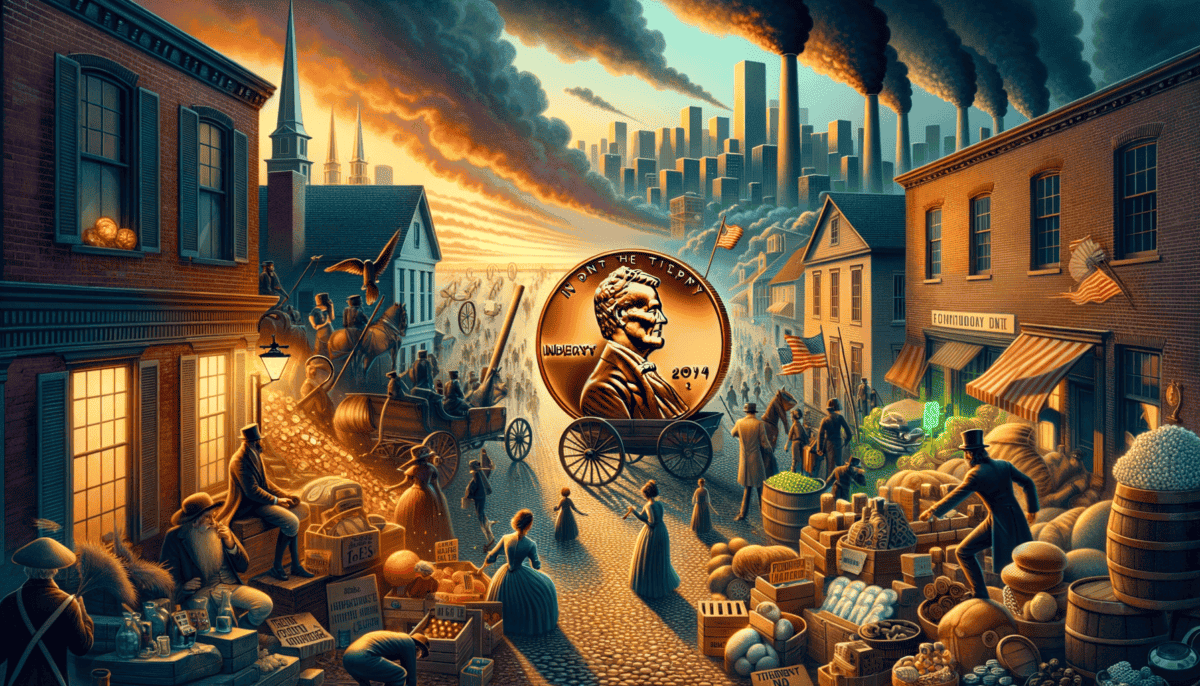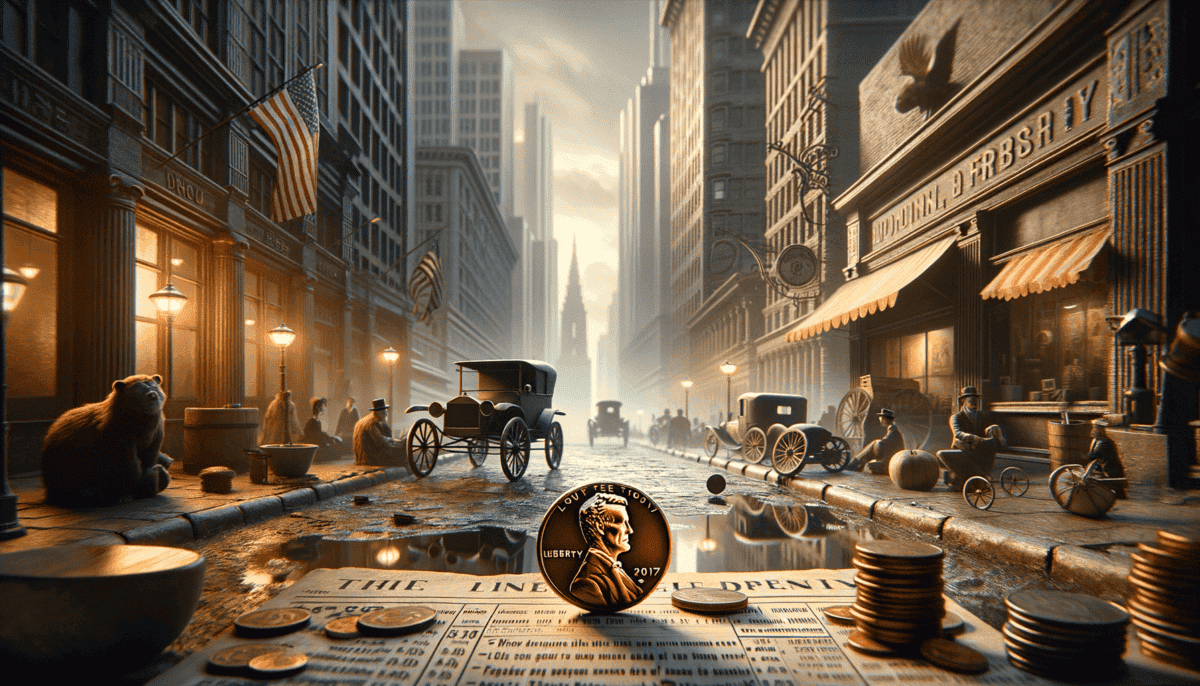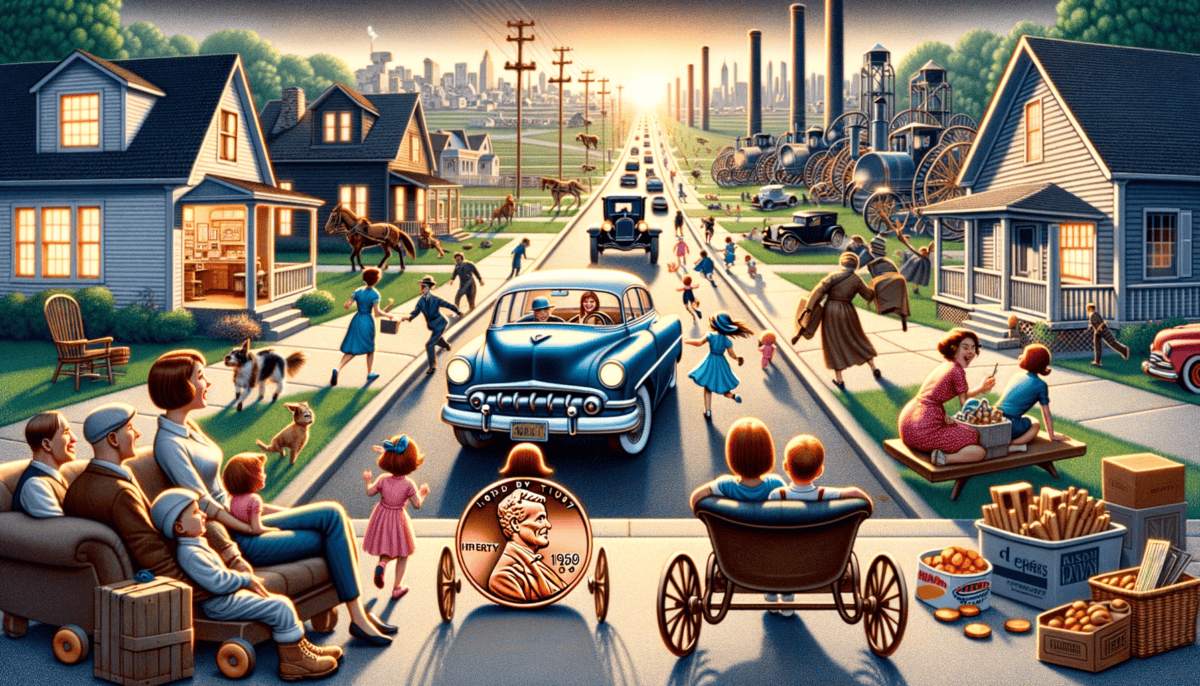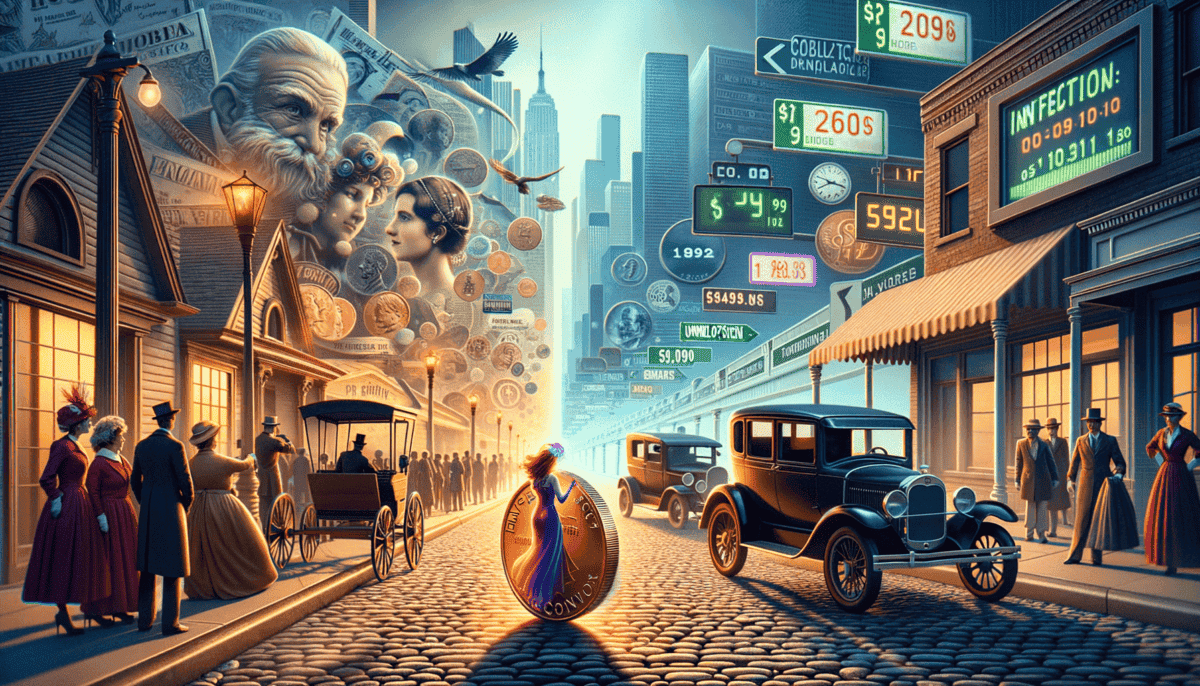The Magical Coin’s First Journey
In Mrs. Thompson's second-grade classroom, a small penny sat quietly in the corner of her desk. But this wasn't just any penny – this was Penny, a very special coin with a magical secret. ✨
"Class, today we're going to learn about money," Mrs. Thompson announced with a bright smile.
Little Sarah raised her hand. "My mom says a penny doesn't buy much anymore."
Just then, something amazing happened. The copper penny began to glow with a soft, golden light. Nobody noticed except Tommy, who sat in the front row with wide eyes.
Penny could feel excitement building inside her round copper body. After years of waiting, it was finally time for her first adventure! With a tiny pop that only Tommy heard, she disappeared from Mrs. Thompson's desk.
WHOOSH
Suddenly, Penny found herself in a busy colonial marketplace in 1775. The air smelled like fresh bread and burning wood. People walked around in long coats and fancy dresses.
"Two shillings for a loaf of bread!" called out a baker.
Penny watched as people used all sorts of different money:
• British pounds
• Spanish silver dollars
• Paper bills called "Continentals"
• Native American wampum beads
A young boy named Benjamin picked up Penny from the dusty street. "Father, look! What kind of coin is this?"
"How strange," his father said, examining Penny closely. "I've never seen markings like these before."
Benjamin put Penny in his pocket, where she listened to fascinating conversations about the new nation being born. People talked about making their own money instead of using British coins.
"We should have our own American money," Benjamin's father said to his friend. "How can we be free if we still use the King's coins?"
Tommy's voice suddenly echoed through time: "Mrs. Thompson! The penny on your desk – it's gone!"
FLASH ⚡
Penny reappeared on Mrs. Thompson's desk, still warm from her journey through time. Tommy blinked twice, wondering if he had imagined the whole thing.
Mrs. Thompson picked up Penny and held her up for the class to see. "This small coin has a big story to tell. Did you know that American money started right around the time of the Revolutionary War?"
While the other students leaned forward to look at the tiny copper coin, Tommy could have sworn he saw Penny glowing again, getting ready for another adventure through time.
Sarah looked closely at Penny. "But why did they make pennies if they're not worth much?"
Mrs. Thompson smiled. "That's an excellent question, Sarah. And it leads us to another fascinating story about how money changes over time…"
The classroom clock ticked steadily, and Penny felt the familiar tingle of time-travel magic building up again. Where would she go next? What other money mysteries would she discover? Only time would tell…
[The chapter ends with Penny beginning to glow once more, setting up the transition to her next historical adventure.]
Wartime Prices and Changes
Penny felt the familiar tingle of magic as she spun through time once again. This time, she landed in a small general store in 1863, right in the middle of the Civil War. ️
“Flour is now $25 a barrel!” called out Mr. Wilson, the shopkeeper. “Sugar is $10 a pound!”
A woman in a long dress gasped. “But last month it was only half that price!”
• A simple dress: From $5 to $50
• A pound of coffee: From 25¢ to $5
• A pair of boots: From $3 to $30
Little Mary, whose father was away fighting in the war, held her mother’s hand tightly. “Mama, why is everything so expensive now?”
“It’s because of the war, dear,” her mother explained softly. “When there’s a war, it’s harder to get the things we need.”
Penny watched from her spot on the counter as people traded different kinds of money. Some used greenbacks – paper money printed by the North. Others used Confederate dollars from the South.
“These Confederate dollars aren’t worth what they used to be,” complained an elderly man. “Last year I could buy a whole week’s food with one. Now it barely buys a day’s meals!”
“When wars happen, money sometimes loses its power to buy things. This is called inflation,” Penny thought to herself, remembering what she learned in Mrs. Thompson’s class.
A young boy named Samuel picked up Penny. “Look what I found, Ma! A strange copper coin!”
“That’s not like any coin I’ve seen before,” his mother said. “Keep it safe – copper is getting rare these days.”
Through Samuel’s pocket, Penny could hear people talking about how the war changed everything:
“Remember when bread was just a few cents?”
“I had to trade my gold coins for paper money.”
“My savings aren’t worth half what they were before the war.”
Samuel carried Penny home, where his family sat around a small table for dinner. They ate simple food – cornbread and beans. His mother carefully counted their remaining money.
“We must be careful with what we have,” she said. “Times are hard, but we’ll make it through together.”
That night, as Samuel slept, Penny thought about how war changes more than just battles – it changes how much things cost and how people live every day.
She could feel the magic starting to build again. The room began to spin, and Samuel’s 1863 bedroom faded away. What would she see next? Where would her journey through time take her?
As she spun through time once more, Penny caught glimpses of other wars and hard times that would test America. But she also saw something else – people helping each other, finding new ways to live, and staying strong even when times were tough.
The familiar glow began to surround her once again, and Penny knew she was about to learn even more about how money changes through time…
The Roaring Twenties and the Big Crash
Penny landed with a soft clink on a shiny marble floor. The year was 1925, and everything sparkled with excitement!
“Look at that new car in the window!” a boy shouted. “Only $290 for a Model T Ford!”
• Radios for music
• Cars to drive around
• Pretty dresses and suits
• New machines for their homes
“The stock market is going up again!” called a man in a fancy suit. “Everyone’s getting rich!”
Penny watched from the busy sidewalk as people rushed by with shopping bags. A little girl named Emma picked her up.
“Papa says this is the best time ever to be alive,” Emma told Penny. “He says money grows on trees now!”
But Penny felt worried. She remembered from her classroom lessons that something big was about to happen.
*Four years later – 1929*
The happy times stopped very fast. One day in October, everything changed.
“The stock market crashed!” people cried in the streets. “All our money is gone!”
Emma’s family had to leave their big house. They moved to a small apartment. Her dad couldn’t find work anymore.
“At least we have each other,” Emma’s mom said, hugging her tight. “And look – we still have this special penny I found years ago.”
Penny watched as prices went down instead of up. A loaf of bread that cost 10 cents now cost just 5 cents. But this wasn’t good – people had no money to buy anything.
Outside banks, long lines formed:
“Please, I need my money!”
“The bank says our savings are gone!”
“What will we do now?”
But something amazing happened. People started helping each other:
– Neighbors shared food from their gardens
– Communities made soup kitchens to feed hungry people
– Families took in relatives who needed homes
Emma’s family started a small vegetable garden. They traded extra vegetables for other things they needed. Sometimes they used Penny to buy a loaf of bread.
“Things will get better,” Emma’s dad said. “America always finds a way.”
And slowly, things did start to change. President Roosevelt made new plans to help people get jobs and food. Banks became safer. People started to hope again.
Penny felt the familiar warm glow beginning. As she started to spin away from the Great Depression, she knew she would never forget what she learned: money could disappear quickly, but people’s kindness and hope stayed strong.
The world began to blur around her as she prepared for her next journey through time…
The Golden Age of Growth
Penny spun through time and landed on a freshly paved driveway. The year was 1955, and everything looked new and shiny! ✨
A family was moving into a pretty house in a neighborhood called Levittown. Little boxes of homes stretched as far as Penny could see.
“Our very own home, Sarah!” said Dad, hugging Mom tight. “And it only cost $12,000!”
Their son Tommy picked up Penny from the driveway. “Look what I found! A lucky penny for our new house!”
• More people had good jobs
• Families could buy their own homes
• New cars filled the driveways
• Kids had lots of toys
Inside the house, a big TV sat in the living room. The kitchen had a shiny new fridge. Mom’s workspace had a washing machine!
“Remember when we had to wash clothes by hand?” Sarah asked. “Now this machine does it all!”
Tommy ran to show Penny his room. He had toy cars, board games, and even a radio of his own.
“Dad says he can buy us nice things because his job at the factory pays well,” Tommy told Penny. “And Mom works at the phone company too!”
On weekends, the family drove their new Chevrolet to the drive-in movie theater. A movie ticket cost 60 cents. A hamburger was 25 cents. A milkshake was 20 cents.
Tommy’s friend Billy lived next door. His dad was a soldier who came home from the war.
“The government helped my dad go to college,” Billy explained. “Now he’s an engineer! And we got this house with a special loan for soldiers.”
Penny noticed how prices were going up, but it wasn’t scary like before. People had good jobs and could afford the things they needed.
• Fresh fruits all year round
• Frozen TV dinners
• Boxes of cereal
• Cans of soup
“Shopping is so easy now!” Sarah said. “Remember when we had to go to five different stores?”
Tommy kept Penny in a special box with his treasures. He watched his neighborhood grow as more families moved in. New schools were built. Parks appeared. Shopping centers opened.
“This is the American Dream,” Dad said proudly. “If you work hard, you can have a good life.”
“And everyone helps each other,” Mom added. “That’s what makes America strong.”
Penny felt warm watching all the happiness. This was different from the scary crash she saw before. Now, money helped people build better lives.
But as Tommy grew older, Penny noticed new worries in the grown-ups’ talks. They whispered about something called “Cold War” and “Space Race.” Prices kept climbing higher.
The familiar tingling started again. As Penny began to spin away, she knew times would change again. But she had seen how strong people could be when they worked together.
The world started to fade as she prepared for her next time jump…
Dark Clouds Over Sunny Days
Penny landed with a clink on a gas station counter in 1973. A long line of angry cars stretched down the street.
“Sorry folks, no more gas today!” the station owner called out. “Price just jumped to 55 cents a gallon!”
People started shouting. This was very different from the happy times Penny just left. A tired-looking mom picked up Penny while paying for her gas.
“How am I supposed to drive to work?” she sighed. “Everything costs so much more now.”
• Gas stations had long lines
• Food prices went way up
• Many people lost their jobs
• Things cost more but people earned the same
Lisa, the mom who found Penny, drove home to her family. Her daughter Jenny was watching TV news about something called an “oil crisis.”
“Mom, why is everyone so worried about oil?” Jenny asked.
“Well, sweetie,” Lisa explained, “we need oil to make our cars go. But now it’s hard to get, so everything is getting more expensive.” ️
Dad came home looking tired. “The factory cut my hours again,” he said. “And bread is now 75 cents a loaf!”
“Remember when it was only 25 cents?” Lisa shook her head. “How are we supposed to keep up?”
Penny watched as the family sat down to eat dinner. They had soup and sandwiches instead of meat. They turned off lights to save money. They couldn’t go to movies anymore.
Jenny kept Penny in her pocket as she walked to school. The crossing guard, Mr. Thompson, waved hello.
“Times are tough,” he told Jenny. “But we Americans are tougher! We got through hard times before, and we’ll do it again!”
At school, Jenny learned a new word: “stagflation.” It meant prices went up while many people lost their jobs. That had never happened before!
The teacher showed the class how to make a budget. “When money is tight,” she said, “we have to plan carefully.”
After school, Jenny helped her mom clip coupons from newspapers. They made a game of finding the best deals.
• Buy things on sale
• Use coupons
• Grow vegetables at home
• Fix old clothes instead of buying new ones
The whole neighborhood worked together. Mrs. Garcia next door shared vegetables from her garden. Mr. Lee taught everyone how to fix their cars. The Williams family started a carpool.
“When times get hard,” Lisa told Jenny, “good neighbors become like family.” ️
Penny watched as months passed. The gas lines got shorter, but prices stayed high. Jenny’s dad found a new job, but it paid less than his old one.
“We can’t control what happens,” Lisa said, “but we can control how we handle it.”
One day, while helping Jenny count her piggy bank savings, Penny felt the familiar tingle. The world was changing again, and she knew it was time to move on.
As she began to spin away, Penny remembered the brave families who faced hard times together. They showed her that money problems couldn’t break the American spirit. ⭐
Building Tomorrow Together
Penny spun through time one last time, landing with a gentle ping on a modern classroom desk. The year was 2024, and things looked very different!
“Class, today we’re learning about how prices change,” Ms. Rodriguez announced. “Does anyone know what inflation means?”
Little Maria raised her hand. “My mom says it’s why our groceries cost more now!”
Penny smiled to herself. She had seen so many changes in prices through time. A candy bar that once cost 5 cents now cost two whole dollars!
• People use phones to pay for things
• Robots help at stores
• Banks work through computers
• Prices change faster than before
“Look what I found!” Maria picked up Penny. “It’s an old penny!” ✨
Ms. Rodriguez used this as a teaching moment. “Did you know that penny could buy a whole loaf of bread a long time ago?”
The children’s eyes grew wide. “No way!” they shouted.
Maria’s friend Tommy chimed in, “My grandpa tells stories about gas costing 30 cents a gallon!”
Ms. Rodriguez showed the class a special computer that tracked prices. “See how things change? But we have tools to help us deal with it!”
The children learned about something called the Federal Reserve, which helped keep prices from changing too fast. It was like a big team of money doctors! ⚕️
“The most important thing,” Ms. Rodriguez explained, “is that we all work together when prices go up.”
Penny watched as the kids shared stories about saving money. Some had piggy banks, others had special apps. Maria’s family grew vegetables just like families did in the 1970s!
During recess, the children played “store” with toy money. They learned how to make good choices when prices changed.
The class project that day was to interview family members about money stories. Tommy’s grandpa talked about the 1970s gas lines. Maria’s mom shared tips about smart shopping.
“Money changes,” Ms. Rodriguez said, “but working together never goes out of style!”
As the school day ended, Penny felt proud. She had traveled through time and seen the American spirit stay strong through all kinds of money problems.
“Remember,” Ms. Rodriguez told her class, “we’re all on the same team. When prices go up, we help each other out!”
Maria carefully placed Penny in her pocket. Maybe this little coin would keep sharing its magic with future children, teaching them about money’s big adventure through time.
And so, Penny’s journey came to an end, but the lessons she learned would last forever: Money might change, but hope, helping others, and working together would always be America’s richest treasure. ⭐️






